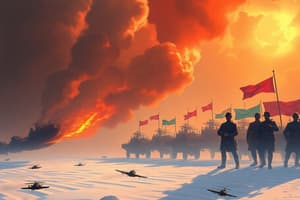Podcast
Questions and Answers
What are the characteristics of great powers according to the text?
What are the characteristics of great powers according to the text?
- Historical significance and political stability
- Cultural dominance and technological advancement
- Large population and territorial expansion
- Military and economic strength, diplomatic and soft power influence (correct)
Which organizations formally recognize the status of great powers?
Which organizations formally recognize the status of great powers?
- European Union and ASEAN
- Congress of Vienna and United Nations Security Council (correct)
- NATO and G7
- World Trade Organization and International Monetary Fund
Which nations are permanent members of the United Nations Security Council?
Which nations are permanent members of the United Nations Security Council?
- Germany, Japan, India, Brazil, and South Africa
- China, France, Russia, the United Kingdom, and the United States (correct)
- Australia, Canada, Italy, Spain, and Mexico
- Saudi Arabia, Turkey, South Korea, Indonesia, and Egypt
What are the dimensions into which great power status can be characterized according to international relations theorists?
What are the dimensions into which great power status can be characterized according to international relations theorists?
What is the role of great powers in influencing middle or small powers according to the text?
What is the role of great powers in influencing middle or small powers according to the text?
Flashcards are hidden until you start studying




